A Comprehensive Experimental Emulation for OTFS Waveform RF-Impairments
Abstract
:1. Introduction
1.1. Related Work
1.2. Motivation and Contribution
- Experimental research of the nonlinearity effect on the performance of the OTFS system has been investigated, taking into account a variety of delay bins N and Doppler bins M and comparing it with an OFDM waveform.
- The CFO influence was studied and emulated using a reverberation chamber and stirrer. The impact of CFO from LO mismatching and CFO from Doppler shift on the OTFS waveform’s performance is shown experimentally over a variety of normalized frequency offset values.
- We visualize and present the effect of the DC-offset on both the in-phase() and quadrature () components, and then we show the effect of the DC-offset on the OTFS system performance and compare it with OFDM.
- Furthermore, the phase noise of a practical 2.4 GHz CMOS voltage control oscillator (VCO) is modeled to examine its impact on the OTFS performance.
- Finally, we study the influence of the I/Q-imbalance on the performance of the OTFS while taking into account imperfections in the local oscillator. We did this by comparing the OTFS and OFDM waveforms with different values of gain imbalance () and phase offset ().
1.3. Organization
2. Waveform Modulation and Demodulation
2.1. OFDM Waveform
2.2. OTFS Waveform
2.3. Channel Estimation and MP Detection
3. Channel Effects Furthermore, RF-Impairments
3.1. Carrier Frequency Offset
3.1.1. CFO Due to Doppler Shift
3.1.2. CFO Due to Frequency Mismatching between the TX and RX Oscillators
3.2. Non-Linearity Impairments
3.3. I/Q Imbalance
3.4. DC Offset
3.5. Phase Noise
4. Conclusions
Author Contributions
Funding
Institutional Review Board Statement
Informed Consent Statement
Data Availability Statement
Conflicts of Interest
Abbreviations
| 5G | Fifth Generation |
| 6G | Sixth Generation |
| A/D | Analog-to-Digital |
| BER | Bit Error Rate |
| CCDF | Cumulative Distribution Function |
| CFO | Carrier Frequency Offset |
| CP | Cyclic Prefix |
| D/A | Digital-To-Analog() |
| DC | Direct Current |
| eMBB | Enhanced-Mobile Broadband |
| I/Q imbalance | In-Phase And Quadrature Imbalance |
| ICF | Iterative Clipping And Filtering |
| ICI | Inter-Carrier Interference |
| ISFFT | inverse symplectic finite Fourier transform |
| ISI | Inter-Symbol Interference |
| JRC | Joint Radar Communication |
| LNA | Low-Noise Amplifier |
| LS | Least Squares |
| MIMO | Multi-Input Multi Output |
| mMTC | Massive Machine Type Communications |
| mm-Wave | millimeter wave |
| MP | Message Passing |
| NOMA | Non-Orthogonal Multiple Access |
| OFDM | Orthogonal Frequency Division Multiplexing |
| OTFS | Orthogonal Time-Frequency Space |
| PA | Power Amplifier |
| PAPR | Peak-To-Average Power Ratio |
| PSW | Prolate Spheroida Waveform |
| QAM | Quadrature Amplitude Modulation |
| RF | Radio-Frequency |
| SDR | Software-Defined Radio |
| SFFT | Symplectic Finite Fourier Transform |
| SLM | improved SeLective Mapping |
| URLLC | Ultra-Reliable And Low Latency Communications |
| VSA | Vector Signal Analyzer |
| VSG | Vector Signal Generator |
| RCF | Raised-cosine filter |
| LO | Local oscillator |
| HPA | high power amplifier |
| OOB | out-of-band |
| AWGN | additive white Gaussian noise |
| CMOS | complementary metal-oxide-semiconductor |
| VCO | voltage control oscillator |
References
- Cisco Visual Networking Index. Forecast and Trends, 2017–2022 White Paper; Cisco Systems Inc.: San Jose, CA, USA, 2019. [Google Scholar]
- Ankarali, Z.E.; Peköz, B.; Arslan, H. Flexible radio access beyond 5G: A future projection on waveform, numerology, and frame design principles. IEEE Access 2017, 5, 18295–18309. [Google Scholar] [CrossRef]
- Jaradat, A.M.; Hamamreh, J.M.; Arslan, H. Modulation options for OFDM-based waveforms: Classification, comparison, and future directions. IEEE Access 2019, 7, 17263–17278. [Google Scholar] [CrossRef]
- Zegrar, S.E.; Arslan, H. Common CP-OFDM Transceiver Design for Low-Complexity Frequency Domain Equalization. IEEE Wirel. Commun. Lett. 2022. [Google Scholar] [CrossRef]
- Doğan-Tusha, S.; Arslan, H. 6G Vision: An Ultra-Flexible Radio Access Technology Perspective. arXiv 2020, arXiv:2009.07597. [Google Scholar]
- Hadani, R.; Monk, A. OTFS: A new generation of modulation addressing the challenges of 5G. arXiv 2018, arXiv:1802.02623. [Google Scholar]
- Hadani, R.; Rakib, S.; Tsatsanis, M.; Monk, A.; Goldsmith, A.J.; Molisch, A.F.; Calderbank, R. Orthogonal time frequency space modulation. In Proceedings of the 2017 IEEE Wireless Communications and Networking Conference (WCNC), San Francisco, CA, USA, 19–22 March 2017; pp. 1–6. [Google Scholar]
- Schenk, T.C.W. RF Impairments in Multiple Antenna OFDM: Influence and Mitigation; Technische Universiteit Eindhoven: Eindhoven, The Netherlands, 2006. [Google Scholar]
- Raviteja, P.; Phan, K.T.; Hong, Y.; Viterbo, E. Orthogonal Time Frequency Space (OTFS) Modulation Based Radar System. In Proceedings of the 2019 IEEE Radar Conference (RadarConf), Boston, MA, USA, 22–26 April 2019; pp. 1–6. [Google Scholar] [CrossRef] [Green Version]
- Gaudio, L.; Kobayashi, M.; Caire, G.; Colavolpe, G. On the effectiveness of OTFS for joint radar parameter estimation and communication. IEEE Trans. Wirel. Commun. 2020, 19, 5951–5965. [Google Scholar] [CrossRef]
- Zegrar, S.E.; Arslan, H. Effect of Prefix/Suffix Configurations on OTFS Systems with Rectangular Waveforms. arXiv 2022, arXiv:2205.1487. [Google Scholar]
- Ding, Z.; Schober, R.; Fan, P.; Vincent Poor, H. OTFS-NOMA: An Efficient Approach for Exploiting Heterogenous User Mobility Profiles. IEEE Trans. Commun. 2019, 67, 7950–7965. [Google Scholar] [CrossRef] [Green Version]
- Ge, Y.; Deng, Q.; Ching, P.C.; Ding, Z. OTFS Signaling for Uplink NOMA of Heterogeneous Mobility Users. IEEE Trans. Commun. 2021. [Google Scholar] [CrossRef]
- Hadani, R.; Rakib, S.; Molisch, A.F.; Ibars, C.; Monk, A.; Tsatsanis, M.; Delfeld, J.; Goldsmith, A.; Calderbank, R. Orthogonal Time Frequency Space (OTFS) modulation for millimeter-wave communications systems. In Proceedings of the 2017 IEEE MTT-S International Microwave Symposium (IMS), Honololu, HI, USA, 4–9 June 2017; pp. 681–683. [Google Scholar] [CrossRef]
- Wiffen, F.; Sayer, L.; Bocus, M.Z.; Doufexi, A.; Nix, A. Comparison of OTFS and OFDM in Ray Launched sub-6 GHz and mmWave Line-of-Sight Mobility Channels. In Proceedings of the 2018 IEEE 29th Annual International Symposium on Personal, Indoor and Mobile Radio Communications (PIMRC), Bologna, Italy, 9–12 September 2018; pp. 73–79. [Google Scholar] [CrossRef] [Green Version]
- Ren, H.; Xu, W.; Wang, L. Multiple-Mode Orthogonal Time Frequency Space with Index Modulation. Electronics 2022, 11, 2600. [Google Scholar] [CrossRef]
- Wu, K.; Zhang, J.A.; Huang, X.; Guo, Y.J. OTFS-based joint communication and sensing for future industrial IoT. IEEE Internet Things J. 2021. [Google Scholar] [CrossRef]
- Monk, A.; Hadani, R.; Tsatsanis, M.; Rakib, S. OTFS-orthogonal time frequency space: A novel modulation meeting 5G high mobility and massive MIMO challenges. arXiv 2016, arXiv:1608.02993. [Google Scholar]
- Li, S.; Yuan, J.; Yuan, W.; Wei, Z.; Bai, B.; Ng, D.W.K. Performance Analysis of Coded OTFS Systems Over High-Mobility Channels. IEEE Trans. Wirel. Commun. 2021, 20, 6033–6048. [Google Scholar] [CrossRef]
- Surabhi, G.; Augustine, R.M.; Chockalingam, A. Peak-to-average power ratio of OTFS modulation. IEEE Commun. Lett. 2019, 23, 999–1002. [Google Scholar] [CrossRef]
- Marsalek, R.; Blumenstein, J.; Schützenhöfer, D.; Pospisil, M. OTFS modulation and influence of wideband RF impairments measured on a 60 GHz testbed. In Proceedings of the 2020 IEEE 21st International Workshop on Signal Processing Advances in Wireless Communications (SPAWC), Atlanta, GA, USA, 26–29 May 2020; pp. 1–5. [Google Scholar]
- Gao, S.; Zheng, J. Peak-to-average power ratio reduction in pilot-embedded OTFS modulation through iterative clipping and filtering. IEEE Commun. Lett. 2020, 24, 2055–2059. [Google Scholar] [CrossRef]
- Naveen, C.; Sudha, V. Peak-to-average power ratio reduction in OTFS modulation using companding technique. In Proceedings of the 2020 5th International Conference on Devices, Circuits and Systems (ICDCS), Coimbatore, India, 5–6 March 2020; pp. 140–143. [Google Scholar]
- Bitra, H.; Ponnusamy, P.; Chintagunta, S. Reduction of PAPR in OTFS using normalized μ-law and A-law companding transform. Internet Technol. Lett. 2022, 5, e344. [Google Scholar] [CrossRef]
- Liang, W.; Liu, X.; Shi, J.; Li, L.; Hu, J. Underlying Security Transmission Design for Orthogonal Time Frequency Space (OTFS) Modulation. Sensors 2022, 22, 7919. [Google Scholar] [CrossRef]
- Neelam, S.G.; Sahu, P.R. Error performance of OTFS in the presence of IQI and PA Nonlinearity. In Proceedings of the 2020 National Conference on Communications (NCC), Kharagpur, India, 21–23 February 2020; pp. 1–6. [Google Scholar]
- Tusha, A.; Doğan-Tusha, S.; Yilmaz, F.; Althunibat, S.; Qaraqe, K.; Arslan, H. Performance analysis of OTFS under in-phase and quadrature imbalance at transmitter. IEEE Trans. Veh. Technol. 2021, 70, 11761–11771. [Google Scholar] [CrossRef]
- Naikoti, A.; Chockalingam, A. A DNN-based OTFS transceiver with delay-Doppler channel training and IQI compensation. In Proceedings of the 2021 IEEE 32nd Annual International Symposium on Personal, Indoor and Mobile Radio Communications (PIMRC), Helsinki, Finland, 13–16 September 2021; pp. 628–634. [Google Scholar]
- Neelam, S.G.; Sahu, P. Analysis, Estimation and Compensation of Hardware Impairments for CP-OTFS Systems. IEEE Wirel. Commun. Lett. 2022, 11, 952–956. [Google Scholar] [CrossRef]
- Neelam, S.G.; Sahu, P. Digital Compensation of IQ Imbalance, DC offset for Zero-Padded OTFS Systems. IEEE Commun. Lett. 2022. [Google Scholar] [CrossRef]
- Tusha, A.; Dogan-Tusha, S.; Althunibat, S.; Basar, E.; Qaraqe, K.; Arslan, H. Index Modulation-Aided IQ Imbalance Compensator for OTFS Communications Systems. In Proceedings of the 2022 IEEE Wireless Communications and Networking Conference (WCNC), Austin, TX, USA, 10–13 April 2022; pp. 2178–2183. [Google Scholar]
- Surabhi, G.D.; Ramachandran, M.K.; Chockalingam, A. OTFS Modulation with Phase Noise in mmWave Communications. In Proceedings of the 2019 IEEE 89th Vehicular Technology Conference (VTC2019-Spring), Kuala Lumpur, Malaysia, 28 April–1 May 2019; pp. 1–5. [Google Scholar] [CrossRef]
- Thaj, T.; Emanuele, V. OTFS Modem SDR Implementation and Experimental Study of Receiver Impairment Effects. In Proceedings of the 2019 IEEE International Conference on Communications Workshops (ICC Workshops), Shanghai, China, 20–24 May 2019; pp. 1–6. [Google Scholar]
- van de Beek, J.J. Synchronization and Channel Estimation in OFDM Systems. Ph.D. Thesis, Luleå University of Technology, Luleå, Sweden, 1998. [Google Scholar]
- Surabhi, G.; Chockalingam, A. Low-complexity linear equalization for OTFS modulation. IEEE Commun. Lett. 2019, 24, 330–334. [Google Scholar] [CrossRef]
- Fish, A.; Gurevich, S.; Hadani, R.; Sayeed, A.M.; Schwartz, O. Delay-Doppler channel estimation in almost linear complexity. IEEE Trans. Inf. Theory 2013, 59, 7632–7644. [Google Scholar] [CrossRef] [Green Version]
- Ramachandran, M.K.; Chockalingam, A. MIMO-OTFS in high-Doppler fading channels: Signal detection and channel estimation. In Proceedings of the 2018 IEEE Global Communications Conference (GLOBECOM), Abu Dhabi, United Arab Emirates, 9–13 December 2018; pp. 206–212. [Google Scholar]
- Raviteja, P.; Phan, K.T.; Hong, Y. Embedded pilot-aided channel estimation for OTFS in delay–Doppler channels. IEEE Trans. Veh. Technol. 2019, 68, 4906–4917. [Google Scholar] [CrossRef] [Green Version]
- Shen, W.; Dai, L.; An, J.; Fan, P.; Heath, R.W. Channel estimation for orthogonal time frequency space (OTFS) massive MIMO. IEEE Trans. Signal Process. 2019, 67, 4204–4217. [Google Scholar] [CrossRef] [Green Version]
- Blazek, T.; Groll, H.; Pratschner, S.; Zochmann, E. Vehicular channel characterization in orthogonal time-frequency space. In Proceedings of the 2019 IEEE International Conference on Communications Workshops (ICC Workshops), Shanghai, China, 20–24 May 2019; pp. 1–5. [Google Scholar]
- YUAN, Z.; LIU, F.; GUO, Q.; WANG, Z. Message Passing Based Detection for Orthogonal Time Frequency Space Modulation. ZTE Commun. 2022, 19, 34–44. [Google Scholar]
- Narasimhan, T.L.; Chockalingam, A. Channel hardening-exploiting message passing (CHEMP) receiver in large-scale MIMO systems. IEEE J. Sel. Top. Signal Process. 2014, 8, 847–860. [Google Scholar] [CrossRef] [Green Version]
- Ge, Y.; Deng, Q.; Ching, P.; Ding, Z. Receiver design for OTFS with fractionally spaced sampling approach. IEEE Trans. Wirel. Commun. 2021, 20, 4072–4086. [Google Scholar] [CrossRef]
- Raviteja, P.; Phan, K.T.; Jin, Q.; Hong, Y.; Viterbo, E. Low-complexity iterative detection for orthogonal time frequency space modulation. In Proceedings of the 2018 IEEE Wireless Communications and Networking Conference (WCNC), Barcelona, Spain, 15–18 April 2018; pp. 1–6. [Google Scholar]
- Wu, T.; Bie, H.; Wen, J. A Message Passing-Assisted Iterative Noise Cancellation Method for Clipped OTFS-BFDM Systems. Sensors 2022, 22, 3937. [Google Scholar] [CrossRef]
- Raviteja, P.; Phan, K.T.; Hong, Y.; Viterbo, E. Interference Cancellation and Iterative Detection for Orthogonal Time Frequency Space Modulation. IEEE Trans. Wirel. Commun. 2018, 17, 6501–6515. [Google Scholar] [CrossRef] [Green Version]
- Mohammadian, A.; Tellambura, C. RF Impairments in Wireless Transceivers: Phase Noise, CFO, and IQ Imbalance–A Survey. IEEE Access 2021, 9, 111718–111791. [Google Scholar] [CrossRef]
- Kihero, A.B.; Karabacak, M.; Arslan, H. Emulation techniques for small scale fading aspects by using reverberation chamber. IEEE Trans. Antennas Propag. 2018, 67, 1246–1258. [Google Scholar] [CrossRef]
- Arslan, H. Wireless communication signals: A laboratory-based approach. IEEE Commun. Mag. 2022, 60, 10. [Google Scholar]
- Hossain, M.; Sugiura, Y.; Shimamura, T.; Ryu, H.G. DFT-spread OTFS communication system with the reductions of PAPR and nonlinear degradation. Wirel. Pers. Commun. 2020, 115, 2211–2228. [Google Scholar] [CrossRef]
- Yih, C.H. Analysis and compensation of DC offset in OFDM systems over frequency-selective rayleigh fading channels. IEEE Trans. Veh. Technol. 2009, 58, 3436–3446. [Google Scholar]
- Come, B.; Ness, R.; Donnay, S.; Van der Perre, L.; Eberle, W.; Wambacq, P.; Engels, M.; Bolsens, I. Impact of front-end non-idealities on bit error rate performance of WLAN-OFDM transceivers. In Proceedings of the RAWCON 2000. 2000 IEEE Radio and Wireless Conference (Cat. No. 00EX404), Denver, CO, USA, 13 September 2000; pp. 91–94. [Google Scholar]
- Tubbax, J.; Côme, B.; Van der Perre, L.; Deneire, L.; Donnay, S.; Engels, M. Compensation of IQ imbalance in OFDM systems. In Proceedings of the IEEE International Conference on Communications, 2003. ICC’03, Anchorage, AK, USA, 11–15 May 2003; Volume 5, pp. 3403–3407. [Google Scholar]
- Yan, W.; Park, C.H. Filtering technique to lower phase noise for 2.4 GHz CMOS VCO. In Proceedings of the 2008 9th International Conference on Solid-State and Integrated-Circuit Technology, Beijing, China, 20–23 October 2008; pp. 1649–1652. [Google Scholar]

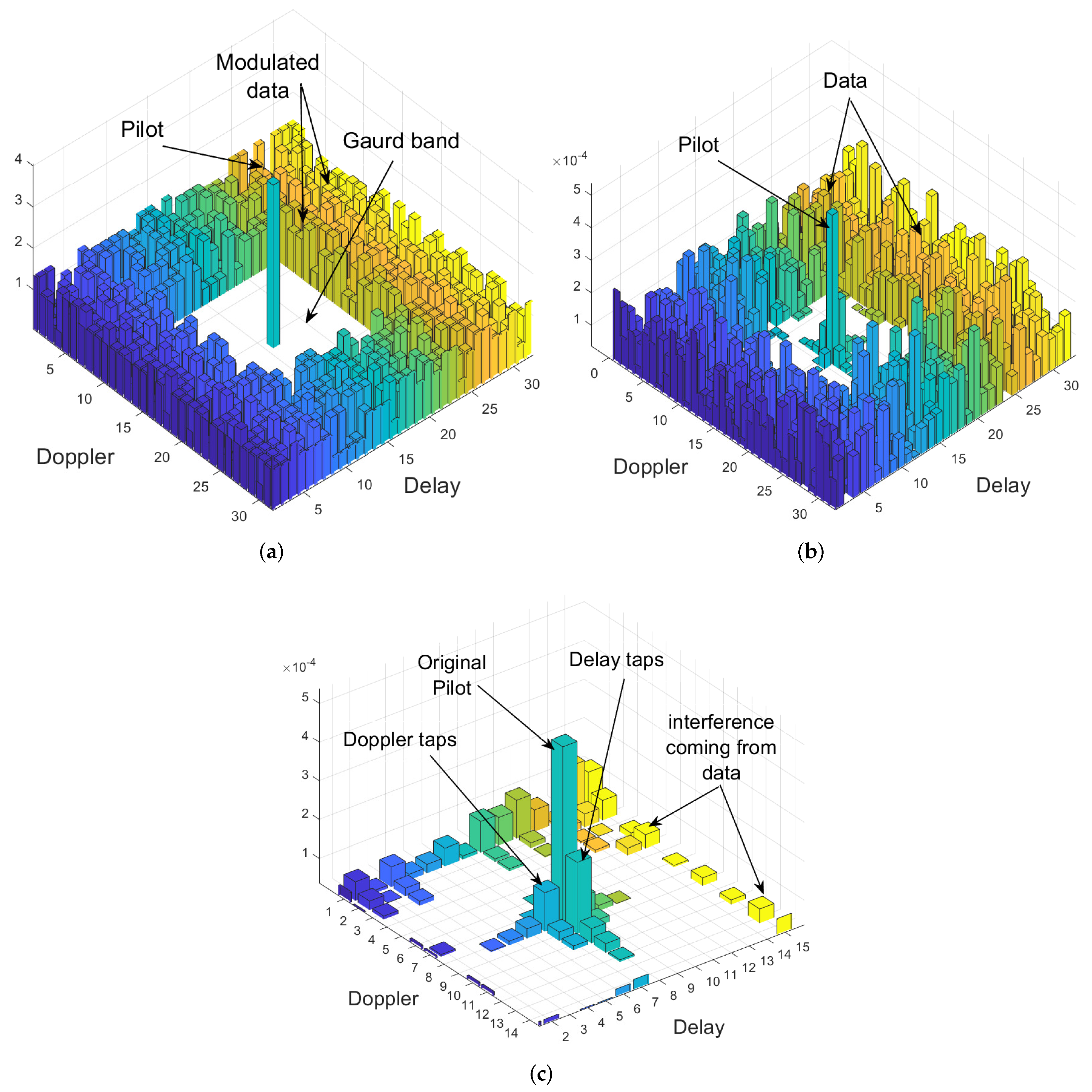
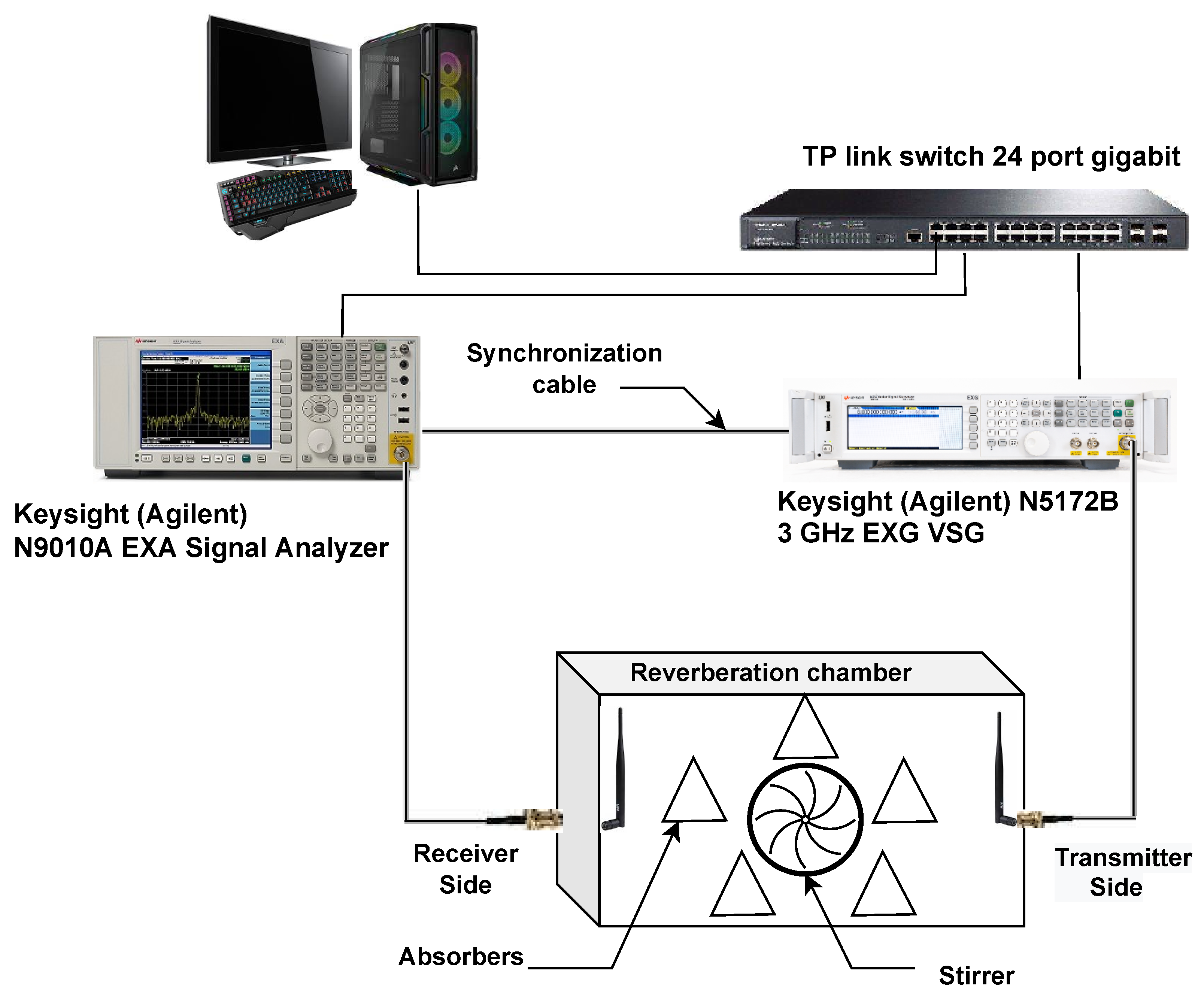
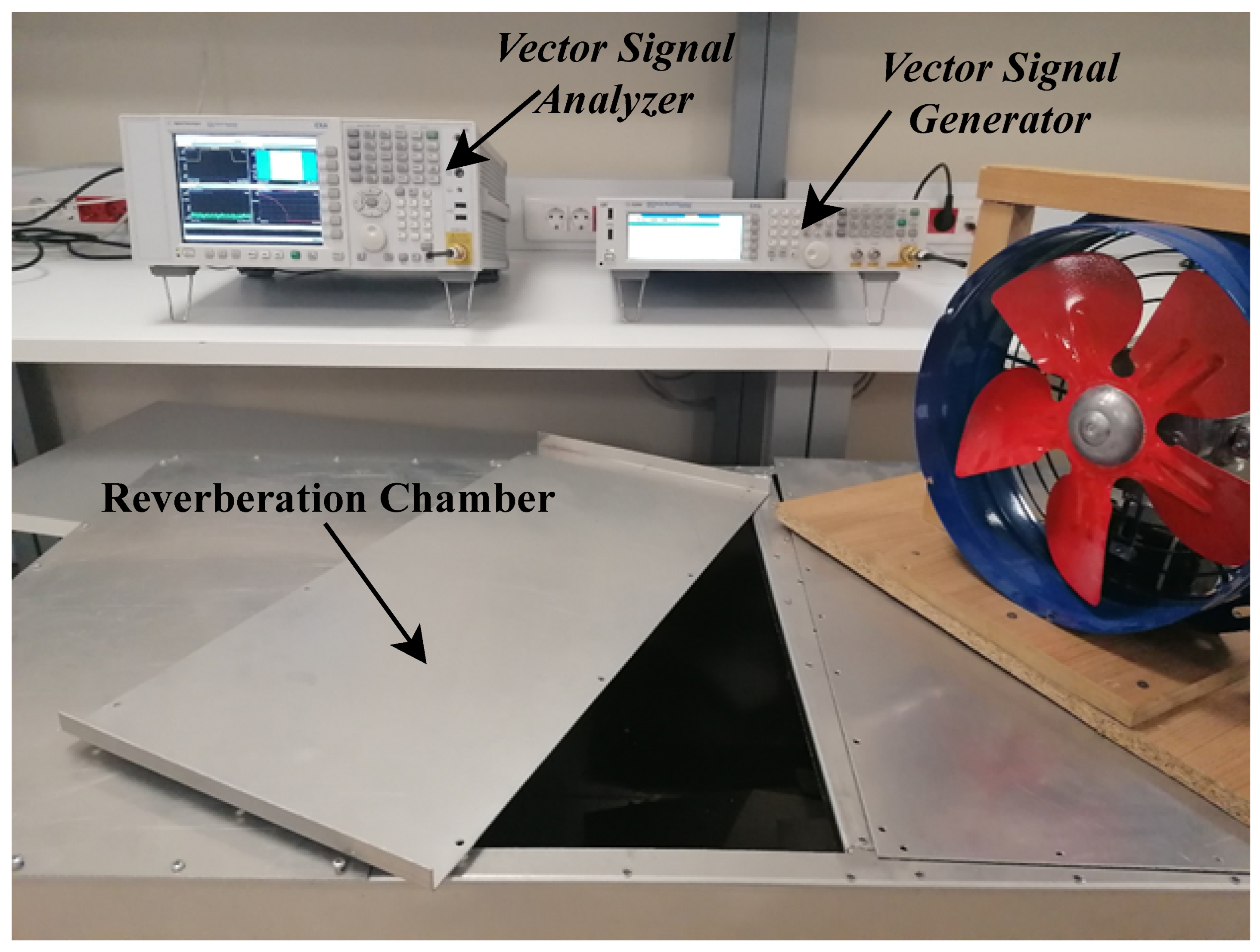


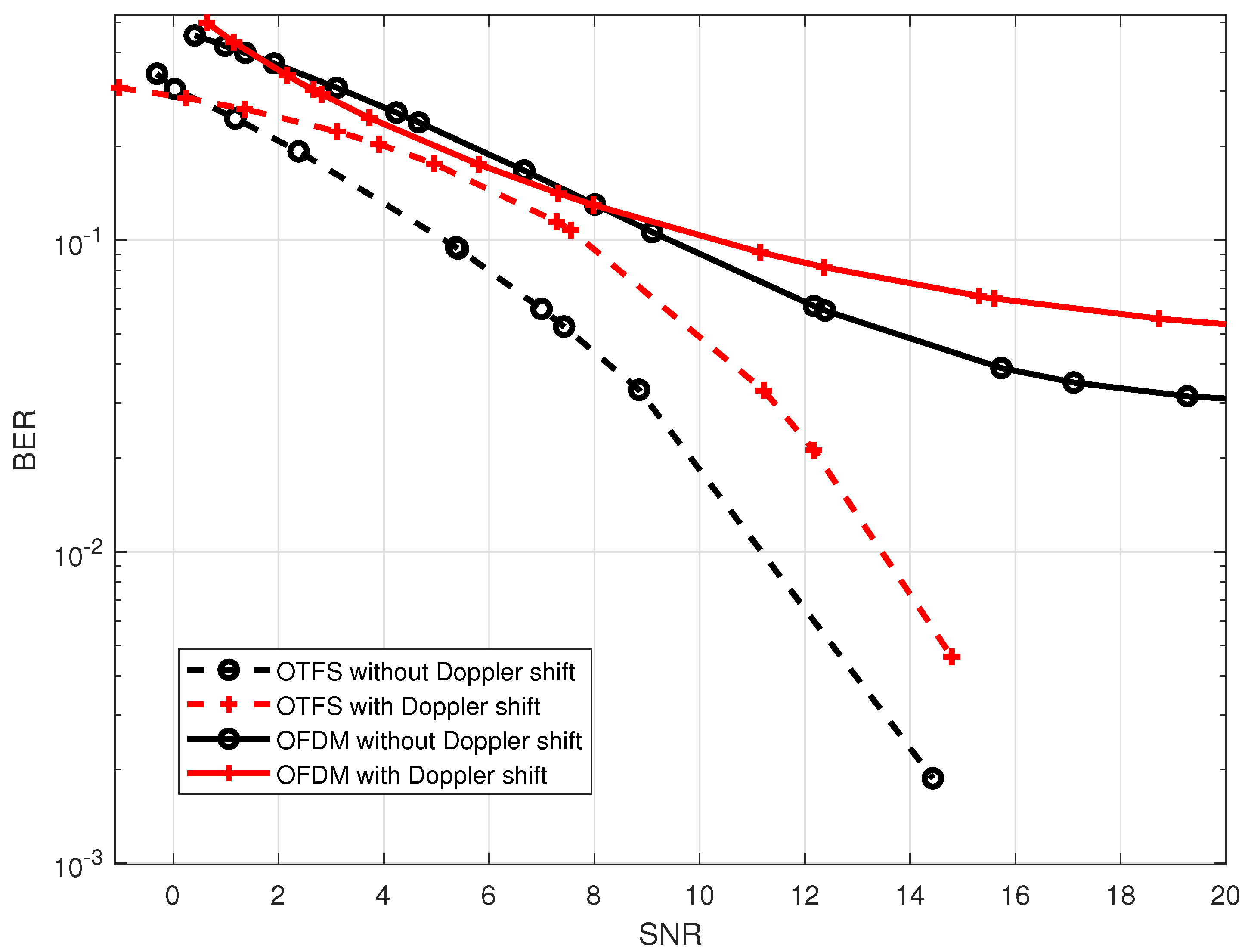
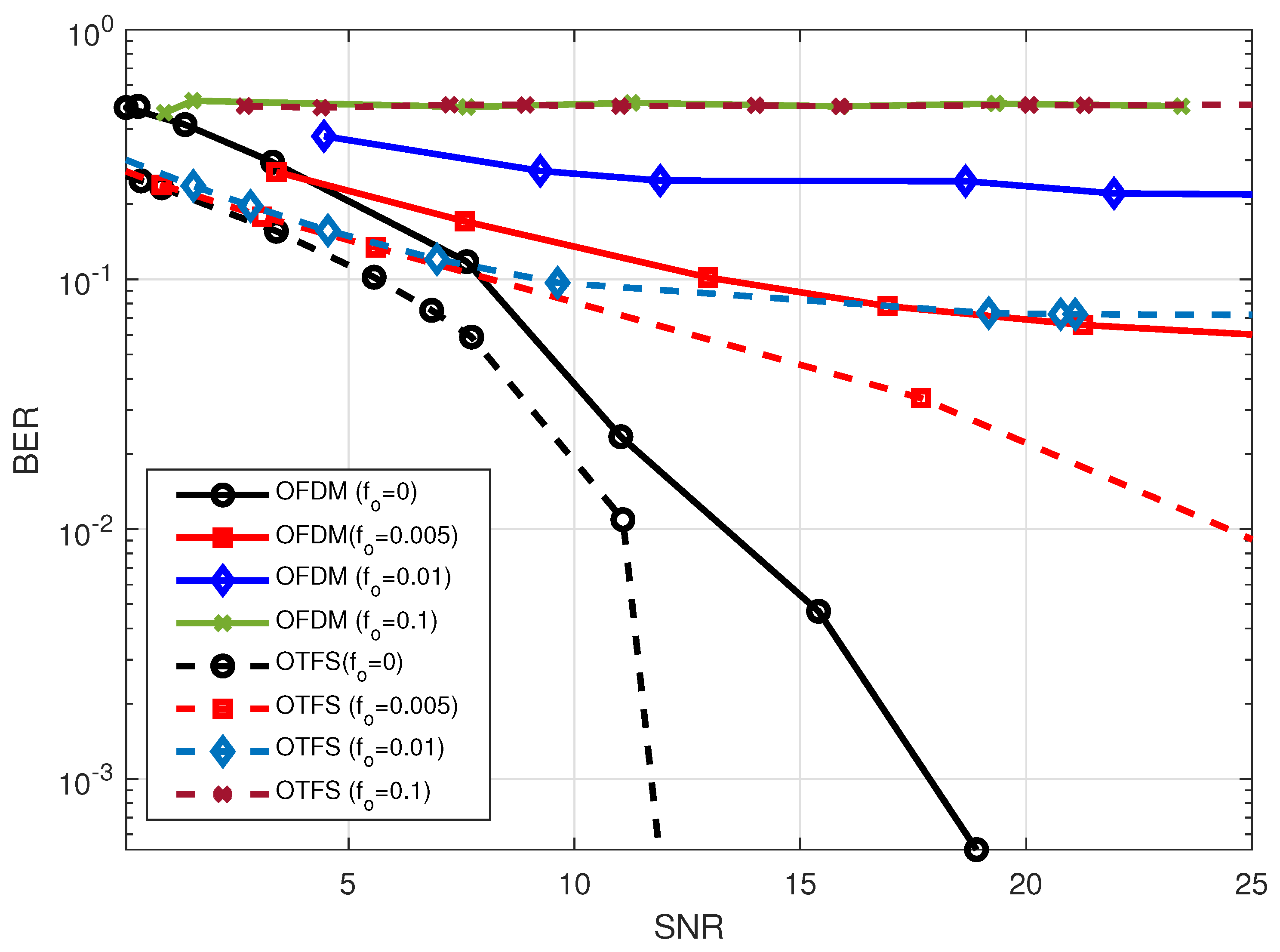


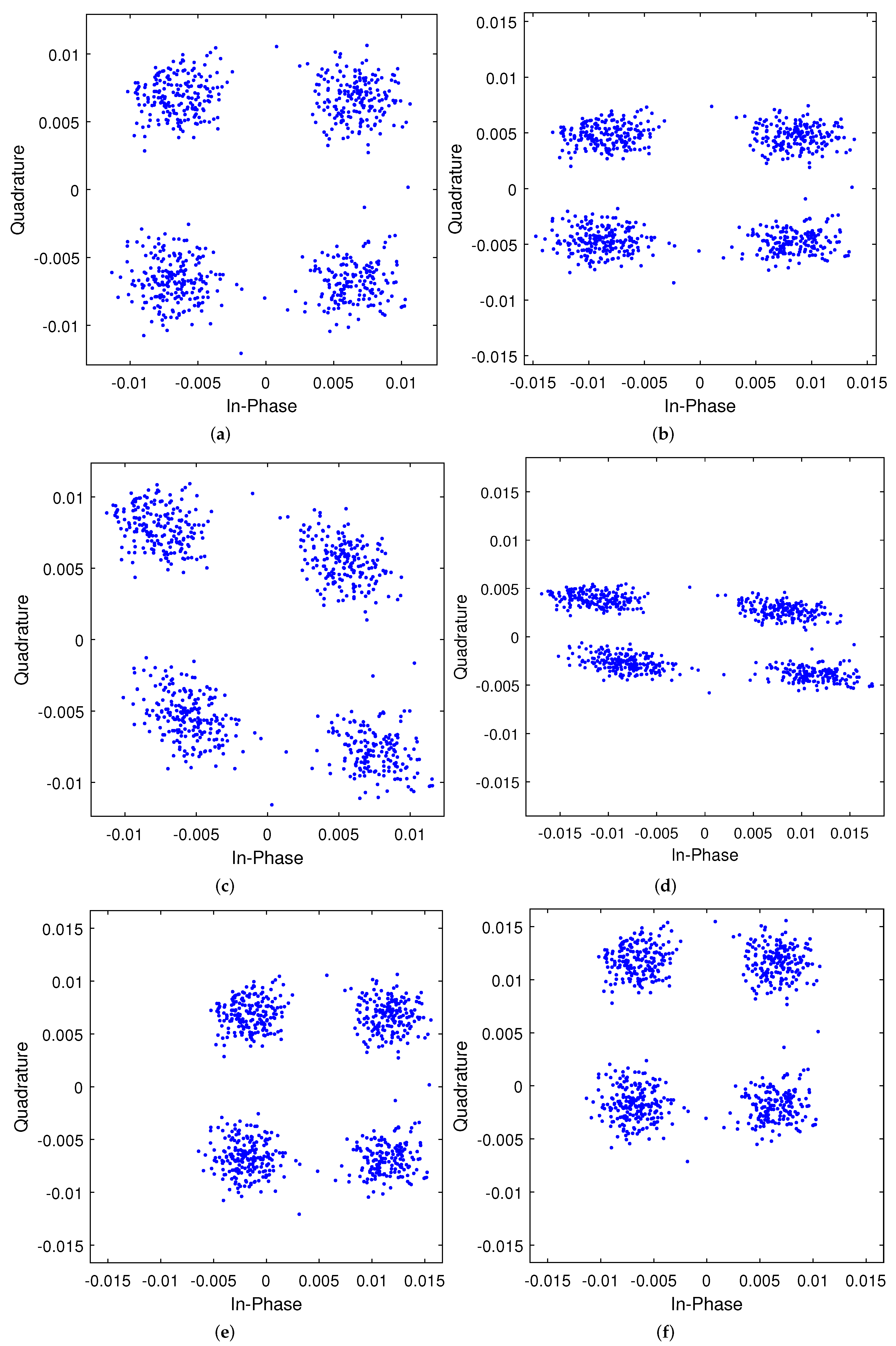

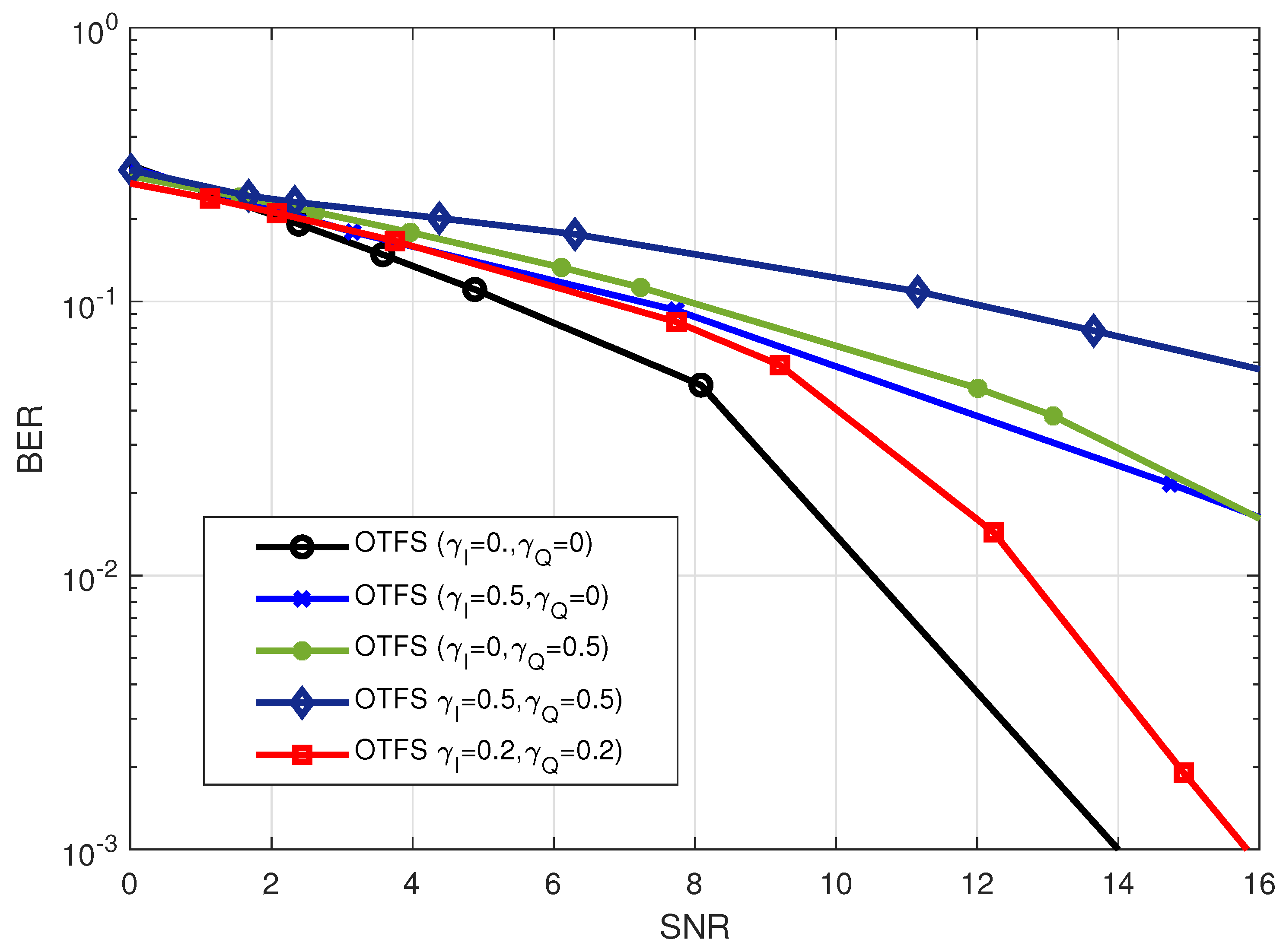

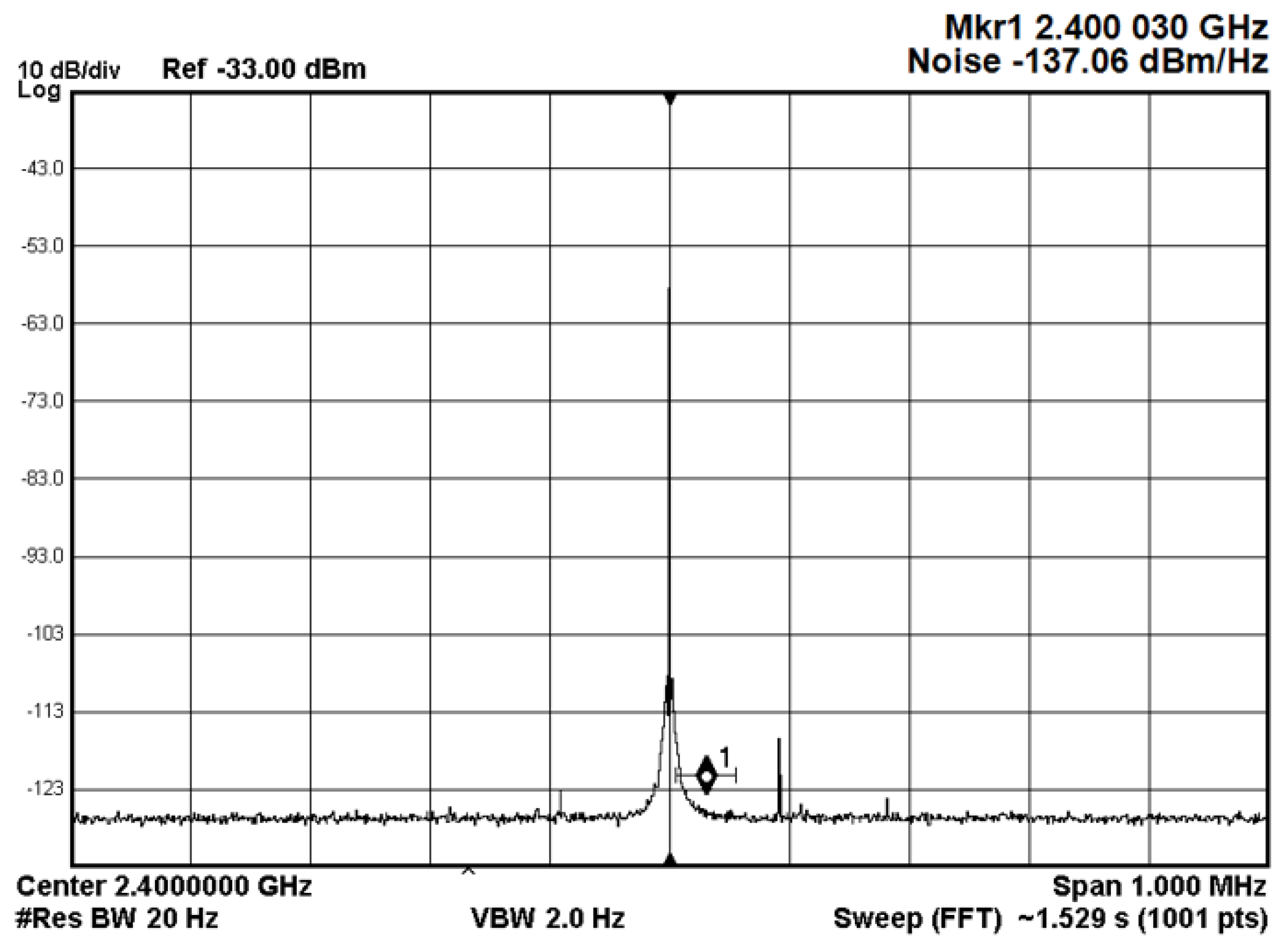

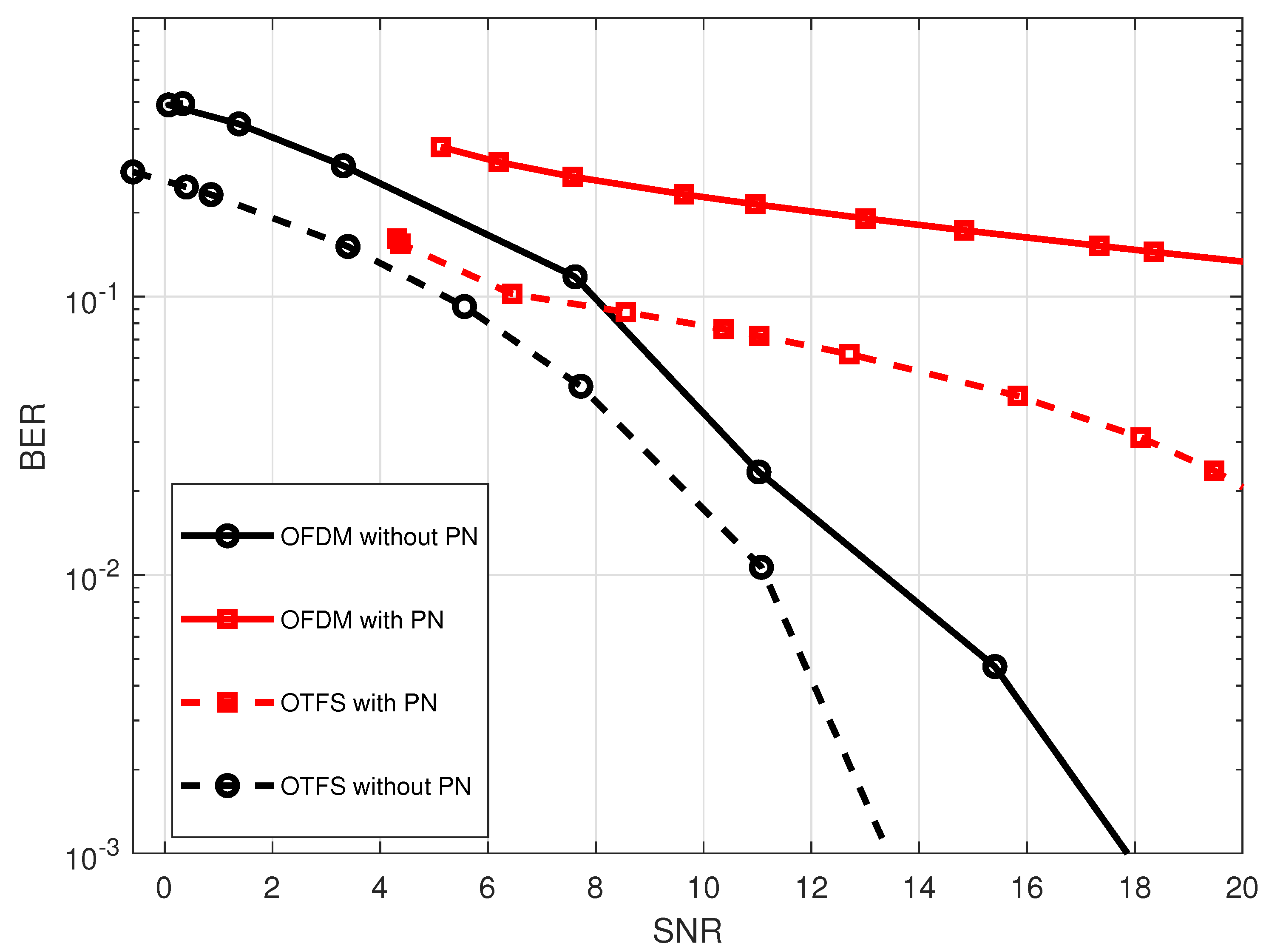
| Symbol | Parameters | Value (OTFS) | Value (OFDM) |
|---|---|---|---|
| Carrier frequency | GHz, 5 GHz | GHz, 5 GHz | |
| M | Number of subcarriers | 432, 256 | 256, 1024 |
| N | Number of symbols | 432, 256 | 1 |
| Symbol duration | s | ||
| Modulation order | 4-QAM | ||
| Sub-carrier spacing | 100 KHz | ||
| Normalized frequency offset | |||
| I/Q gain imbalance | |||
| I/Q phase imbalance | degree | ||
| DC-offset | ( | ||
Disclaimer/Publisher’s Note: The statements, opinions and data contained in all publications are solely those of the individual author(s) and contributor(s) and not of MDPI and/or the editor(s). MDPI and/or the editor(s) disclaim responsibility for any injury to people or property resulting from any ideas, methods, instructions or products referred to in the content. |
© 2022 by the authors. Licensee MDPI, Basel, Switzerland. This article is an open access article distributed under the terms and conditions of the Creative Commons Attribution (CC BY) license (https://creativecommons.org/licenses/by/4.0/).
Share and Cite
Abushattal, A.; Zegrar, S.E.; Yazgan, A.; Arslan, H. A Comprehensive Experimental Emulation for OTFS Waveform RF-Impairments. Sensors 2023, 23, 38. https://doi.org/10.3390/s23010038
Abushattal A, Zegrar SE, Yazgan A, Arslan H. A Comprehensive Experimental Emulation for OTFS Waveform RF-Impairments. Sensors. 2023; 23(1):38. https://doi.org/10.3390/s23010038
Chicago/Turabian StyleAbushattal, Abdelrahman, Salah Eddine Zegrar, Ayhan Yazgan, and Hüseyin Arslan. 2023. "A Comprehensive Experimental Emulation for OTFS Waveform RF-Impairments" Sensors 23, no. 1: 38. https://doi.org/10.3390/s23010038






